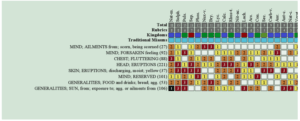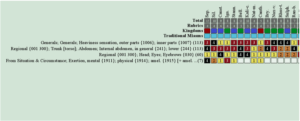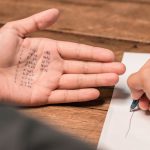Similar Thought: Where Am I?
Joseph Kellerstein, DC, ND
The Value of a Question and Going Back Over Things
Have you ever felt that eerie feeling of uncertainty as you found yourself wondering, “Where the_****_am I?” It might have been trying to find an address with vague instructions, or prior to owning a GPS device. If, like me, you are a chronic Homoeopathic student, it might have happened while taking a case.
How do I get my bearings in a case? What do I focus on?
This excerpt is from Hahnemann’s Lesser Writings: Medicine of Experience (although the emphasis is mine):
The chief signs are those symptoms that are most constant, most striking, and most annoying to the patient. The physician marks them down as the strongest, the principal features of the picture. The most singular, most uncommon signs furnish the characteristic, the distinctive, the peculiar features.
He allows the patient and his attendants to relate all they have to say without interrupting them, and he notes down everything attentively. He then again inquires what were and still are the most constant, frequent, strongest and most troublesome of the symptoms. He requests the patient to describe again his exact sensations, the exact course of the symptoms, the exact seat of his sufferings, and bids the attendants once more detail, in as accurate terms as they are able, the changes they have observed in the patient, and which they had previously mentioned.
So, Hahnemann is saying that the chief features of the picture are those most emphasized by the system and that we are to double check this. Once established, this reliable pattern which characterizes the illness is the gauge by which we assess progress and improvement.
This bedtime tale recounts a case I have only just finished taking. It is not at about a wonderful clinical result, but rather the value of a question and the value of going back over things (iteration).
Scratching the Surface
Tania is 53 years old and presented just this morning with issues that she believes “stem from childhood.” (Inappropriate kissing by a parent.)
The intake form listed 3 complaints:
- Fluttering sensation in the heart.
- Thinning Hair
- Anxiety
There is a past medical history of breast cancer 17 years ago, a hysterectomy 15 years ago, and polycystic ovarian syndrome (PCOS). She explains that the sexual abuse is related to her feeling distrust and her tendency to be passive and yield to others in order to avoid the sense of rejection and lack of protection that she experienced as a child. She can freely express emotion with her husband but no one else.
On reviewing the complaints in depth, I was struck with their inconsistency. The fluttering began after chemotherapy years ago, but is infrequent and not so troublesome. The hair is not really thinning but has become a bit more dry, and Tania is afraid she will, like her mother, have thinning hair in the future. Small, painless bumps appear on her scalp at times, and they might infrequently discharge yellow fluid. There is a history of severe stomach pains that will last for days after consuming products with gluten.
Tania is very sensitive to sunlight, although she enjoys sitting in the sun if she has a hat and sunglasses. She is sensitive to hot, humid weather and finds that it easily exhausts her. Otherwise, she is generally chilly, preferring the bedroom temperature at 70 degrees, and does not use a fan.
At this point, the general picture looks like a slam dunk for Natrum muriaticum.

But wait! The fluttering heart and thinning hair seem inconsistent, almost trivial. The anxiety is definitely there, but anxiety without qualifiers—modality, sensation, and context—is not so useful.
So, again, “Where am I?” I have no clearly defined chief complaint to guide remedy selection.
The Right Question
I review the general issues briefly and wait for a nod or confirmation from the patient before asking the question I have lately been finding extremely useful as a double-check: “Tania, if you found a great medicine and you were much healthier, what would be especially different?”
She answers, “Well, if I were much better, there would not be so much conflict at my core. It’s how I know I am not well.”
“Tania, is there anything else about that conflict at your core?
“It’s a heaviness. A great heaviness in my lower abdomen. It’s why I love to work out. Exercise makes it much better and I feel wonderful.”
(I am jumping up and down inside.) “Anything else about all this?”
“Yes. A few years ago I began to see a therapist because I was not feeling anything. Also, there were headaches, on the left side above my eyes.”
I wonder where all this previously unexposed information came from. Reframing the chief complaint by using the question, “If you were all better what would be different?” has made all the difference. Now I feel confident in Sepia 30, 1 pellet QD for 4 weeks, but one never knows until the patient returns.

 Joseph Kellerstein, DC, ND, graduated as a chiropractor in 1980 and as an ND in 1984. He graduated with a specialty in homeopathy from the Canadian Academy for Homeopathy, and subsequently lectured there for 2 years. He also lectured in homeopathy for several years at CCNM; 8 years at the Toronto School of Homeopathic Medicine; 2 years at the British Institute for Homeopathy. Dr Kellerstein’s mission is the exploration of natural medicine in a holistic context, especially homeopathy and facilitating the experience of healing in patients.
Joseph Kellerstein, DC, ND, graduated as a chiropractor in 1980 and as an ND in 1984. He graduated with a specialty in homeopathy from the Canadian Academy for Homeopathy, and subsequently lectured there for 2 years. He also lectured in homeopathy for several years at CCNM; 8 years at the Toronto School of Homeopathic Medicine; 2 years at the British Institute for Homeopathy. Dr Kellerstein’s mission is the exploration of natural medicine in a holistic context, especially homeopathy and facilitating the experience of healing in patients.









